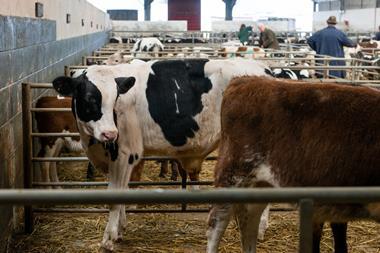Falling Welsh lamb production could lead to supply shortages and higher prices, producers are warning.
The number of breeding ewes in Wales has fallen to below four million for the first time, 5% down on 2008 and 27% below 1997 levels, new Welsh Assembly data reveals. Changing farming methods and producers switching to other produce have been blamed.
In the past 12 months alone the number of sheep and lambs in Wales has fallen 3% to 8.2 million. And although farmers have become more efficient and increased carcase weights to meet demand, producers say the long-term picture is a growing concern.
"We must remain vigilant to ensure that the number of sheep in Wales does not fall below the critical mass required to sustain a viable red meat industry," said Gwyn Howells, chief executive of HCC Meat Promotion Wales. "Further dramatic declines in breeding ewe numbers should be discouraged to ensure we continue to have a thriving industry that can meet the growing demand for Welsh lamb at home and abroad."
The tighter supply has led to higher market prices this year, with deadweight lamb prices rising 30p/kg in the past 12 months, added HCC. "The retail price has also increased and there's a possibility it'll have to go up further," said HCC industry information officer, John Richards.
Supply has also tightened as Welsh producers take advantage of favourable exchange rates to increase exports. Welsh lamb exports were up 20% to £61m in the first seven months of 2009 compared with the same period last year and volume exports were up 5%.
Producers needed to take care that in targeting exports they did not ignore the domestic market, warned HCC chairman Rees Roberts. "The number of livestock kept on our farms continues to shrink, reducing the amount of meat produced in Wales," he said. "If this trend continues unchecked, we could find we are a victim of our own success, with demand outstripping supply."
The number of breeding ewes in Wales has fallen to below four million for the first time, 5% down on 2008 and 27% below 1997 levels, new Welsh Assembly data reveals. Changing farming methods and producers switching to other produce have been blamed.
In the past 12 months alone the number of sheep and lambs in Wales has fallen 3% to 8.2 million. And although farmers have become more efficient and increased carcase weights to meet demand, producers say the long-term picture is a growing concern.
"We must remain vigilant to ensure that the number of sheep in Wales does not fall below the critical mass required to sustain a viable red meat industry," said Gwyn Howells, chief executive of HCC Meat Promotion Wales. "Further dramatic declines in breeding ewe numbers should be discouraged to ensure we continue to have a thriving industry that can meet the growing demand for Welsh lamb at home and abroad."
The tighter supply has led to higher market prices this year, with deadweight lamb prices rising 30p/kg in the past 12 months, added HCC. "The retail price has also increased and there's a possibility it'll have to go up further," said HCC industry information officer, John Richards.
Supply has also tightened as Welsh producers take advantage of favourable exchange rates to increase exports. Welsh lamb exports were up 20% to £61m in the first seven months of 2009 compared with the same period last year and volume exports were up 5%.
Producers needed to take care that in targeting exports they did not ignore the domestic market, warned HCC chairman Rees Roberts. "The number of livestock kept on our farms continues to shrink, reducing the amount of meat produced in Wales," he said. "If this trend continues unchecked, we could find we are a victim of our own success, with demand outstripping supply."


















No comments yet